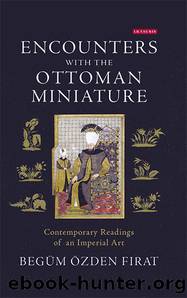Encounters With the Ottoman Miniature (International Library of Visual Culture) by Begüm Özden Firat

Author:Begüm Özden Firat
Language: eng
Format: azw3, mobi, epub
ISBN: 9781780763910
Publisher: I.B.Tauris
Published: 2015-10-29T21:00:00+00:00
Trapped on the Surface
Flatness is one of the formal characteristics of miniature painting. From the seventeenth century onwards, however, miniaturists, most prominently Nakshi Bey, attempted to play with the partial illusion of depth so as to partially expand the pictorial space.17 The portrait of Ahmed III seems to refute such play by filling up, to the extent of horror vacui, the surface of the miniature with two-dimensional ornamentation. This preference for intricately patterned surfaces can be interpreted as an “‘Islamicizing’ trend in Ottoman visual culture, delineating its difference from its European counterpart” at a time when the Empire was going through a systemic process of Westernization (Necipoğlu, 2000: 32). It is plausible that in his effort to revise the stylistic constraints of traditional Imperial portraiture, Levnî might have chosen to impart an effect of horror vacui. Literally meaning “fear of emptiness”, this phrase refers to the act of filling the entire surface of an artwork with ornamental details, figures, shapes, lines, and anything else the artist might envision. Such claustrophobic claiming of the surface of an artwork is conventionally associated with the so-called arts of Islam.18
Whether or not Levnî aimed at such an Islamizing effect extensive ornamentation in the form of horror vacui promotes the aesthetics of the carpet. As I have already noted, Ananth suggests that the profusion of floral and vegetal motifs in the “Islamic” tradition of miniature painting reflects the decorative aesthetics of the carpet (1996, 157). The carpet, he argues, is the example of ornamentation “on a resolutely flat surface, and this is reflected in turn in the miniature painter's treatment of the picture support as something opaque, impermeable” (157). Similarly, the wall and carpet patterns in the portrait seek to reclaim the miniature surface as an opaque entity that is strictly two-dimensional.
Rendered in this way, the ornamentation seems to leave no space for the illusion of depth. However, the imperial throne can be seen as an aperture that pierces the miniature. Because it is diagonally placed, the throne can show the sultan in a three-quarter view and provide an effect of depth. Although the throne is drawn in recessing lines that ostensibly would enhance the three-dimensionality of the miniature's composition – especially its arm side – it is devoid of volume because of the application of the decorative surfaces. It appears not so much as a golden attribute of a powerful sultan but rather as a cut-out chair that has been pasted on the flat, ornamented pictorial space. Moreover, the combinations of floral patterns covering the three parts of the throne – its side, back, and upper parts – looks as if they have been taken from different surfaces and pasted on the throne independently of each other, without consideration of colour or harmony of pattern. Although these randomly assembled pattern-surfaces visibly enrich the symbolic seat of the empire, they also cause it to look like a patchwork picture of an imperial throne. They do so by imposing flatness on the object they decorate.
Corresponding to carpet patterns, the ornaments covering both sides of the throne are depicted frontally.
Download
Encounters With the Ottoman Miniature (International Library of Visual Culture) by Begüm Özden Firat.mobi
Encounters With the Ottoman Miniature (International Library of Visual Culture) by Begüm Özden Firat.epub
This site does not store any files on its server. We only index and link to content provided by other sites. Please contact the content providers to delete copyright contents if any and email us, we'll remove relevant links or contents immediately.
| Dollhouses | Dolls & Doll Clothing |
| Miniatures | Model Trains |
| Models | Stuffed Animals |
| Toymaking | Wood Toys |
On Writing A Memoir of the Craft by Stephen King(4863)
The Doodle Revolution by Sunni Brown(4685)
A Simplified Life by Emily Ley(4098)
Mummy Knew by Lisa James(3630)
Marijuana Grower's Handbook by Ed Rosenthal(3619)
Better Homes and Gardens New Cookbook by Better Homes & Gardens(3524)
Figure Drawing for Artists by Steve Huston(3381)
Paper Parties by Erin Hung(3369)
Draw Your Day by Samantha Dion Baker(3287)
The Genius of Japanese Carpentry by Azby Brown(3224)
Japanese Design by Patricia J. Graham(3109)
The Code Book by Simon Singh(3074)
Dangerous Girls by Haas Abigail(2976)
Lions and Lace by Meagan Mckinney(2922)
The Curated Closet by Anuschka Rees(2912)
How to Make Your Own Soap by Sally Hornsey(2826)
The Checklist Manifesto by Atul Gawande(2776)
The Wardrobe Wakeup by Lois Joy Johnson(2731)
Zero to Make by David Lang(2726)
